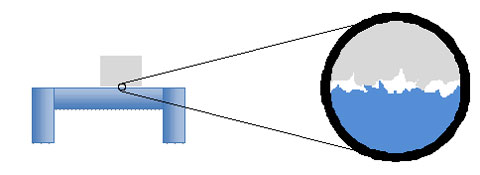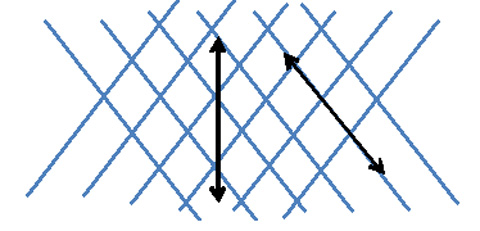Atomic Friction
October 24, 2013
Friction opposes motion, slows things down, and causes a dissipation of energy to surrounding areas. It's also the reason why we can walk, slip, stop, and roll.
Although friction has been studied extensively, scientists still don’t understand it well on the atomic scale. In September 2013, however, scientists reported some new findings – friction has a directional dependence on the atomic scale.1

Back to Basics
Frictional forces oppose an object’s motion or intended motion. Depending on the circumstance, this can be good or bad. Without friction, we wouldn’t be able to walk, run, or drive our cars. On the other hand, friction can also reduce energy efficiency such as the air friction that fights against the motion of vehicles.
Consider the good first. In order to move forward, we need to push back on something. Take walking, for example. The foot pushes the ground opposite to the direction the person wants to move in. The ground, being rough, doesn’t let the foot easily slide over it while also pushing back on the foot.
As Newton’s Third Law states, if object A (foot) pushes on object B (ground) then object B (ground) pushes with an equal force in the opposite direction on object A (foot). Without friction, our feet would slide over the ground and motion would look similar to cartoon characters running in place.
Rolling also requires friction. For a perfect roll, an object must have no sliding motion between the wheel and its point of contact with the ground. If sliding occurs, then the wheel won’t rotate. Consequently, wheels are often made of rubber to help increase the friction between the ground and the wheel (tire).
Vehicles don’t stop without friction. Braking systems are often based on friction. Consider cars with disc brakes: When one pushes on a brake pedal, the brake pad is pushed up against a rotating disc attached to the axle. The friction between the brake pad and disc causes the disc (and axle) to slow down and stop.
Sometimes, however, friction can work against your goal. The force of friction acting on moving objects dissipates energy to the surroundings, causing the surroundings to get warmer. This can be very problematic for engines where parts need to slide past each other without overheating.
Oil reduces the friction in the system, making the engine more efficient. It also helps to keep the engine from overheating by carrying away some of the heat energy.
Now imagine ice skating. When a skater glides over the ice with their skate, they are sliding over a very low friction surface. If the ice becomes rough, gliding doesn’t occur. Not only does this slow down the skater, but it can also cause the skater to tumble.
A Bumpy View
One model of friction, often taught in school, invokes “bumps.” Imagine two smooth surfaces such as a polished counter top and a polished metal block. If the block, resting on the table, is given an initial push, it will slide for a bit then stop.
The smoother we make the surfaces, the farther it will slide. But even the smoothest blocks and table surfaces, when viewed under a microscope, have what appear to be hills and valleys. Those bumps get stuck on each other a bit, causing the block to slow and the surrounding area to heat up.

The hills and valleys between the table and the block get stuck, creating friction.
Smoothing out these bumps has led to recent innovative materials, such as the super slippery material put out by an MIT research team in 2013. This research team created a textured surface that had a repeating pattern on the scale of a billionth of a meter, and then filled the surface with a polymer liquid that stays held in place due to capillary action. This created a super slick surface with very little friction. Just see for yourself how easily ketchup slides out of a bottle made with this material.4
On the nanoscale (billionths of a meter), scientists can measure friction using a method called friction force microscopy. For this method, the scientists measure the loss of energy while the tip of an atomic force microscope moves over a surface that is flat on the atomic level.
The loss of energy stems from chemical interactions with the tip and the atoms making up the surface it is moving over. The nanoscale tip of the microscope is on a cantilever, which bends when the atoms in the tip interact with atoms on the surface it is scanning. (Scientists have the ability to move around individual atoms using this instrument).
But ultimately friction has to do with atomic structure and chemical or electromagnetic interactions between individual atoms.
Atomic Friction
A joint research group decided to use a different method to measure friction at the atomic level. They utilized a lateral force microscope operating in a non-contact mode. In their novel technique, they made the tip and attached cantilever oscillate at its natural frequency. The interaction between the surface and the tip causes the frequency to change, which provided information about how the surface and the tip interacted.
Although some measurements were taken at the atomic level prior to the experiment described below, scientists had difficulty explaining the measurements due to uncertainties about interactions occurring between the tip of the microscope and the surface.
This research team’s newly constructed sensor allowed them to gather better measurements than others had achieved. They oscillated the cantilever and tip parallel to the surface of the substance, making sure no contact between the tip and surface occurred.
Consequently, this technique allowed them to measure interactions between the tip and surface in two directions along the surface, and the resulting lateral forces. They had the added advantage that the material making up the surface, a silicon dimer, is highly symmetric. This symmetry allowed the scientists to study the material without rotating the sample or moving the tip (other than its oscillations).
The surface of the sample is not completely flat. Instead, it is terraced with atomic sized steps to go from one level to the other. The different terraces have a different atomic configuration in which the atomic structure is rotated 90 degrees between the upper and lower steps. Because of this, the researchers could place the tip of the microscope over a step, and then say with 100 percent confidence that the atomic configuration of the tip of the microscope did not change during their measurements, and that the data they collected was in two different directions.
From their measurements they were able to accurately determine that friction, on the atomic level, is very directional (anisotropic). Furthermore, they found that the surface structure and symmetry of chemical bonds were very important in the directional dependence of friction at the atomic and molecular level.1
To understand this, imagine a net in the configuration below. If you run your hand over netting material along one line of netting material, the friction is different than if you run your hand from top to bottom over the material. Along a line of symmetry your hand is less likely to get caught in holes of the net.

Dr. Weymouth, one of the scientists conducting the experiment, described the importance of the research as twofold. “First, when we consider smaller mechanical systems, then friction at the atomic scale is going to be a very strong effect.
We showed here that it can be very well modeled when considering a quantum mechanical picture of the system. Secondly, while it is impossible at this time to construct a quantum mechanical simulation of a macroscopic object (the computing power is not there) we can start to understand how single atomic asperities [unevenness of surface] interact and try to construct a better fundamental understanding of friction.”
The Road Ahead
When asked about future research and applications, Dr. Weymouth noted that the system could be used to investigate the friction over adsorbates (molecules adhering to a surface).
If the molecules align over the silicon surface they used, then they could apply the same techniques to measure the friction over two directions. Dr. Weymouth said that this could be very useful to increase understanding of how molecular structure affects the motion of a molecule over a surface.
Dr. Weymouth also mentioned doing the experiment with lower temperatures, which increases the precise control over the tip of the microscope. He explained that this would allow them to be certain that the tip remains the same even when changing samples, or rotating samples. They could then study lateral forces directly on almost any sample.
References and Resources
1. Weymouth, A.J. et al., “Atomic Structures Affects the Directional Dependence of Friction,” Phys. Rev. Let. 111, 126103 (2013)http://prl.aps.org/abstract/PRL/v111/i12/e126103
2. Egberts, P. and Carpick, R.W., “Viewpoint: Friction at the Atomic Scale,” Physics, 6, 102 (2013)
http://physics.aps.org/articles/v6/102
3. Moskowitz, C., “Why Friction is a Drag: New Findings,” Scientific American, 24 September 2013
http://blogs.scientificamerican.com/observations/2013/09/24/why-friction-is-a-drag/
4. Stauffer, N. W. “Novel slippery surfaces: Improving steam turbines and ketchup bottles,” MIT Energy Initiative, June 2013
http://mitei.mit.edu/news/novel-slippery-surfaces-improving-steam-turbines-and-ketchup-bottles
—Heide Doss














